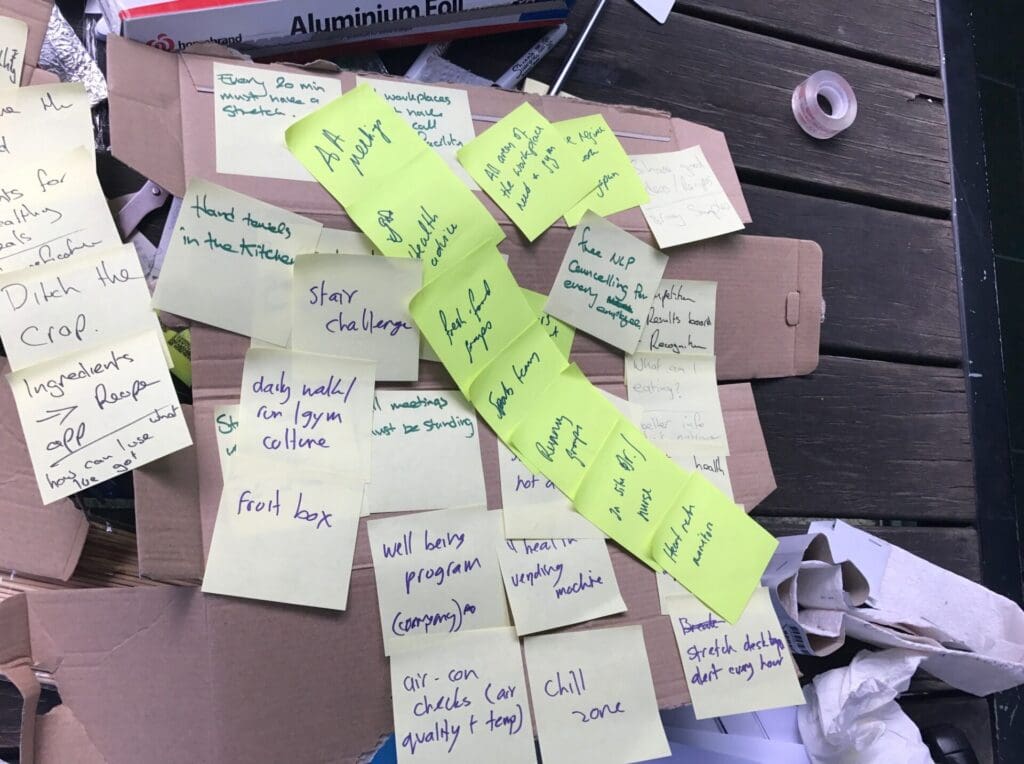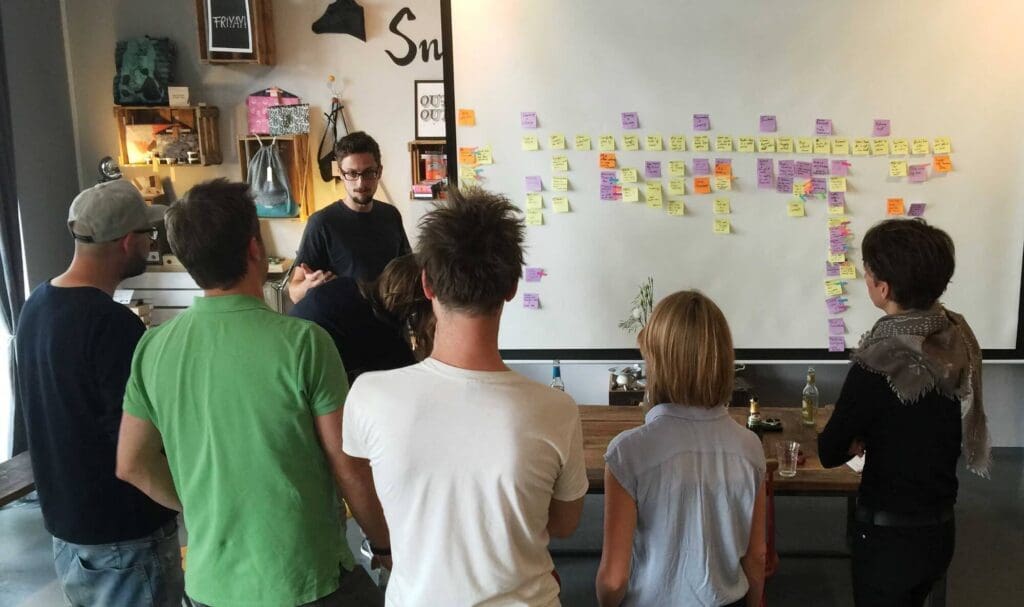The meetings that matter happen in person. That’s abundantly clear. While teams can conduct some communications over Slack or Zoom productively, as human beings, we need face-to-face interaction to be at our best.
Nowhere is this perhaps more obvious than when we are trying to drum up new ideas! Sitting behind a screen, it can feel impossible to get into a creative flow with our peers. As more and more organizations switch to remote and hybrid working models, managers are seeing how vital it is to draw teams together in real life for their brainstorming sessions.
What makes in-person brainstorming a more productive meeting?
Every organization needs fresh and innovative ideas to stay ahead of the competition. But to give their best, employees must feel confident and part of the group. Breeding the trust and sense of community required for coworkers to share their greatest ideas is hard to do in virtual settings.
Crucial non-verbal cues get lost when we speak to each other through a screen which is why the creative juices that flow from gathering in person are impossible to replicate online. Or, as our CEO phrased it;
“My core belief: the important things in life happen in person. This belief comes from the magic and the energy that bursts when we get together in person. Bursts of understanding when we can read beyond someone’s words and listen beyond someone’s voice. Bursts of trust when we support each other with honest gestures. Bursts of inspiration when we solve hard problems and create new things together.”
Avi Meir – CEO & Co-founder of TravelPerk
As we will see, brainstorming sessions not only provide an incubator for ideas. They can also act as vital opportunities for team bonding. Hosting these meetings in person can be a chance to draw together different elements of the business, get new perspectives and help remote colleagues network outside their usual silos.
15 tips to run a genuinely successful brainstorming session
1. Get clear on your goals
The notion of coming together with colleagues for real-time idea generation is exciting, especially when coworkers are spread out across different locations. But without clear aims, you are unlikely to get the desired results.
In the new remote and hybrid working world, it’s more important than ever to be able to demonstrate an ROI for your brainstorming session. Colleagues are no longer down the hall, and your organization could be investing some serious cash to bring everyone together.
Summarize what you want to get out of your brainstorming session. You should be able to boil down your goals into a snappy sentence such as “generate three marketing strategies for our latest product.”
2. Pick your participants
Now that your goals are cemented, it’s time to decide which colleagues to involve. As the old proverb says, too many cooks spoil the broth, so it’s best to keep the invitation list in the single digits.
In a survey from the Harvard Business Review, researchers discovered that having too many minds in your brainstorming meetings can be detrimental to the process. A large group of people may end up being a waste of time as a few members take the stage and leave others feeling drowned out.
With your aims in mind, think about which employees have the expertise to bring creative ideas to the table. You will need coworkers who understand the project or problems you are tackling, but it can also pay to bring in a fresh pair of eyes. On top of including members from the main team or department, consider throwing in a wild card who can shake things up on the day with a new perspective.
3. Select a suitable space
As the traditional office space evolves and changes, businesses have an exciting opportunity to think outside the box when planning their next brainstorming session. Our brains are geared towards novelty, so what could be more galvanizing than gathering teams in a new location?
Maybe your employees would feel reinvigorated by the unrivaled buzz of New York City? Or perhaps you are a team of nature lovers that would prefer to meet in the great outdoors? With Airbnb for Work, hiring an inspiring venue for team meetings has never been easier.
If budget restraints mean a team offsite is off the table, consider switching things up closer to HQ. Rent a meeting room in a cool hotel or coworking space, or head outside to a nearby park. Anything that could get your participants out of their day-to-day and in the mood to innovate.
4. Be prepared
Now that you have assembled the details, it’s time to let everyone know. Give plenty of notice not just to ensure everyone can make arrangements to attend but to give participants time to start mulling over some ideas.
As well as the practical elements, like time and location, ensure that everyone knows your objectives for the session. You can even ask attendees to come with a few ideas so you can hit the ground running on the day. These don’t need to be fully formed, just loose concepts you can explore as a group.
It’s also wise to establish a few ground rules before the session so that participants know what will be expected of them. Some simple boundaries for group brainstorming could include:
Be constructive in your comments. This session will be a judgment-free creative process where all ideas have value.
Please keep your thoughts concise when sharing with the group, so we don’t exceed our allotted amount of time.

5. Find a facilitator
A ship without a captain will run aground. Without a facilitator at the helm, it’s easy for a brainstorming session to get derailed and head into territory that won’t yield useful results. Picking a neutral leader who can steer the meeting when it gets off course is crucial, but they must have the right skills to draw the best out of everybody.
A great facilitator is someone who can:
Use their listening skills to great effect – they pick up on all the details, keeping the conversation from heading off-topic while giving everyone a chance to speak.
Keep track of time – They instinctively know which ideas to develop and when it’s necessary to move on.
Enforce the ground rules – a good facilitator knows how to handle participants who disrupt the session.
6. Break the ice
How you open your brainstorming meeting can be the difference between shaping the next big idea or navigating an hour of awkward silences. It’s important to warm up the group with a low-risk icebreaker to kick start the creative thinking and set a friendly tone. Ask an off-the-wall question where there are no wrong answers. Something like “if you had one wish, what pain point would you remove for this project?” could reveal some interesting insights.
7. Direct the discussion
It’s easy to get off track. Throughout your brainstorming session, your facilitator should be wary when conversations stray off course and carefully redirect the team back to the question or challenge at hand.
Guiding the session also includes ensuring everyone has had ample opportunity to speak. Quieter members of the group might need a little more encouragement and may find it hard to jump in if more extroverted participants dominate the conversation. Factor in time to go around each coworker and ask for their thoughts before summarizing the session.
8. Take note
It’s no good drumming up a host of amazing ideas if you don’t remember how you got them. Rather than relying on a picture of your mind map or a scribble-covered whiteboard, designate someone to take minutes. While this might seem a bit extreme, it will provide a more accurate record of what you achieve and keep track of how your concepts developed throughout the session.
9. Rate your revelations
As your brainstorming session winds down, evaluate and decide which concepts you will take forward. Rank your ideas until you have a top three. You can do this as a team, in smaller groups, or as individuals. The important thing is to ensure you leave the room with actionable insights.
10. Keep the momentum
A brainstorm is only as successful as its results. Schedule follow-up meetings to feed back ideas to relevant parties and plan the next steps to implement those you want to pursue. Don’t be afraid to assign these tasks to other team members and set deadlines to check in on progress.
It’s also important to get some feedback on the session itself. Create a short survey on Google forms where attendees can share their thoughts anonymously on what worked well and what could be improved for future groups.

11. Build-in moments for quiet reflection
We all know the feeling of trying to generate fresh ideas while dealing with a chatty’s colleague’s running commentary! Sometimes in a brainstorming session, participants will naturally fall into moments of quiet self-reflection. But if more extroverted members leave little room in the conversation, factor in a few minutes of silence so participants can gather their thoughts before sharing with the group.
12. Ensure teams have all the information
Ideas are only valuable if they are realistic. It’s important that teams have as much background and information as possible to be able to provide feasible concepts or solutions. These details might include budget or time constraints that could influence their insights. Prep your participants with an email outlining everything they need to consider so they can start chewing over concepts ahead of the session.
13. Make allowances for anonymity
Any team will feature a few introverted members who might find it a challenge to share their ideas out loud. Creating a method where participants can submit their thoughts anonymously before and after the brainstorming session can help you draw out different perspectives you might otherwise miss.
14. Try different brainstorming techniques
Feeling stuck? Switch up your brainstorming methods. Try a rapid-fire brainwriting approach by setting a timer and asking contributors to write down as many ideas as possible in two minutes. Alternatively, opt for a round-robin where each person shares one opinion before coming together to discuss as a group. Lastly, you can ask your team to try role storming. This brainstorming tool is where they put themselves in the place of someone else (like the boss) and try to solve the problem from their perspective.
15. Finish up with something fun
As we alluded to earlier, in-person brainstorming is a much-needed opportunity for remote teams to reconnect with their coworkers. A staggering 73% of employees miss being social with their colleagues. Celebrating a successful session with a business lunch or an after-work happy hour can provide valuable team building and motivation when employees return to WFH.
Looking to plan an inspiring brainstorming offsite for your team? Reach out to our events team today to see how we can support you with stress-free corporate travel.
The post 15 tips to run a (really) productive in-person brainstorming session appeared first on TravelPerk. For more on travel.


